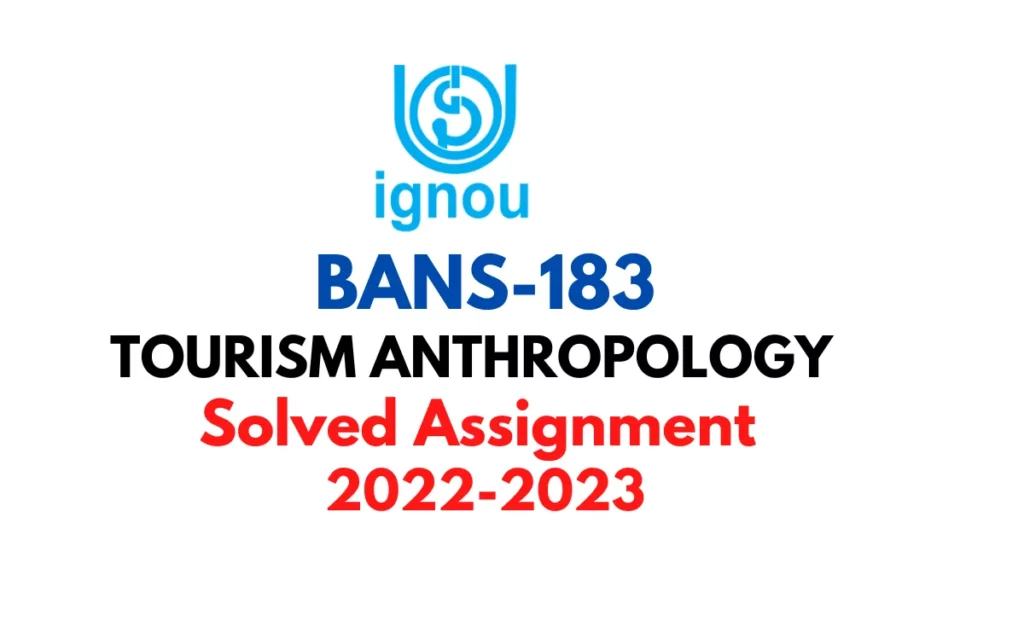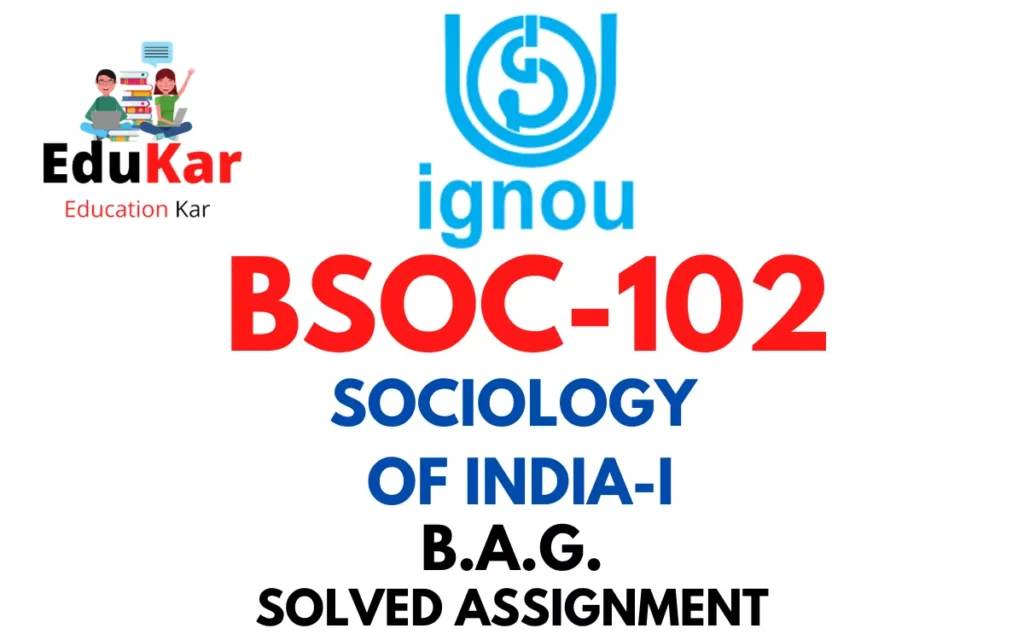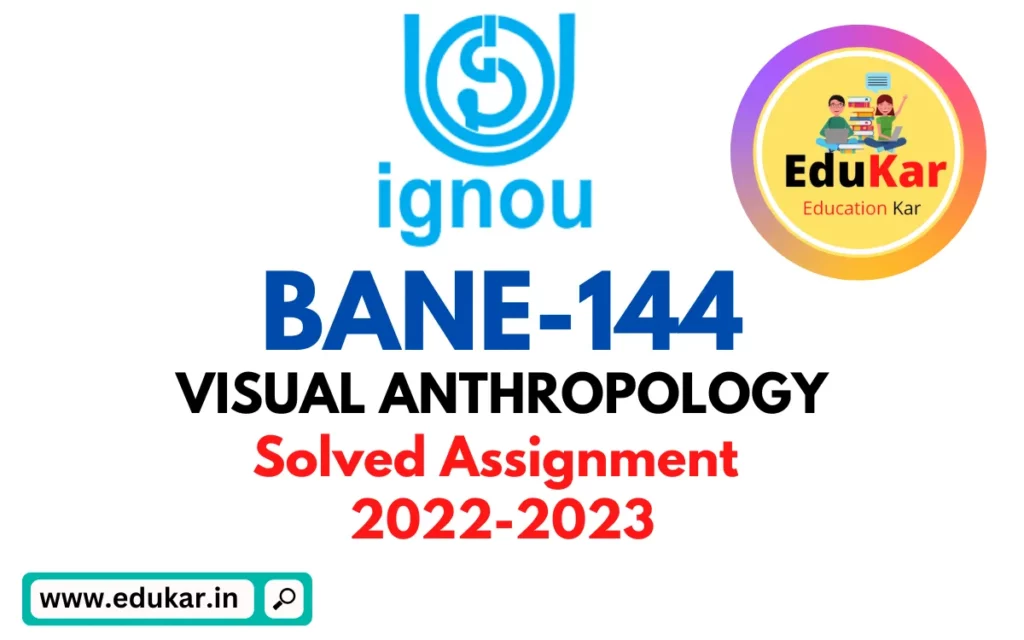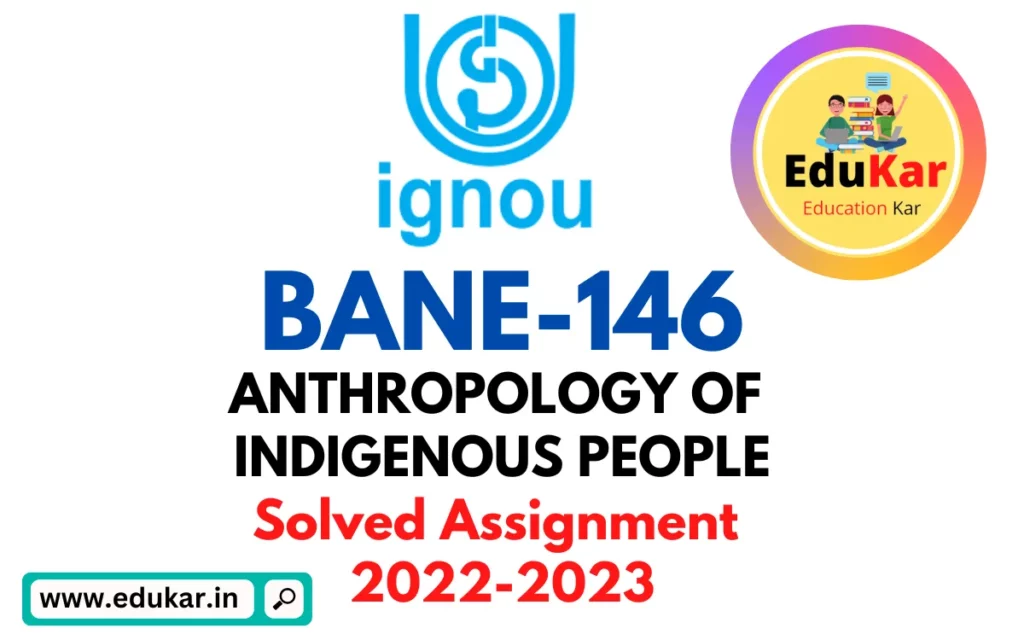Contents
- 1 Assignment – I
- 2 Answer the following in about 500 words each. 20X2= 40
- 3 a. Discuss the characteristics and geographical distribution of tribes in India.
- 4 b. Write a note on the anthropology of Tribes in India.
- 5 Assignment – II
- 6 Answer the following in about 250 words each. (Write Short Notes) 10X2=20
- 7 a. Deliberate on the tribal movements with examples.
- 8 b. Write a note on the forest policies and tribes.
- 9 Answer the following questions in about 75 words each. 2X5=10
- 10 a. Indigenous communities
- 11 b. Tribal displacement and rehabilitation
- 12 c. Globalisation and tribes
- 13 d. Problems of tribal women
- 14 e. Tribes and social change
- 15 Assignment – III
- 16 a. Write a synopsis to present how you would conduct ethnographic research in a tribal community. Justify the unit of study in your synopsis.
- 17 b. Discuss the qualitative analysis of data and report writing for the synopsis that you proposed in (Assignment III a).

| Title | BANE-143 |
| University | IGNOU |
| Degree | Bachelor Degree Programme |
| Course Code | BANE-143 |
| Course Name | TRIBAL CULTURES OF INDIA |
| Programme Name | Bachelor of Arts (General) |
| Programme Code | BAG |
| Total Marks | 100 |
| Year | 2022-2023 |
| Language | English |
| Assignment Code | BANE 143/ASST/TMA/July 2022 and January 2023 |
| Last Date for Submission of Assignment: | For June Examination: 31st April For December Examination: 30th September |
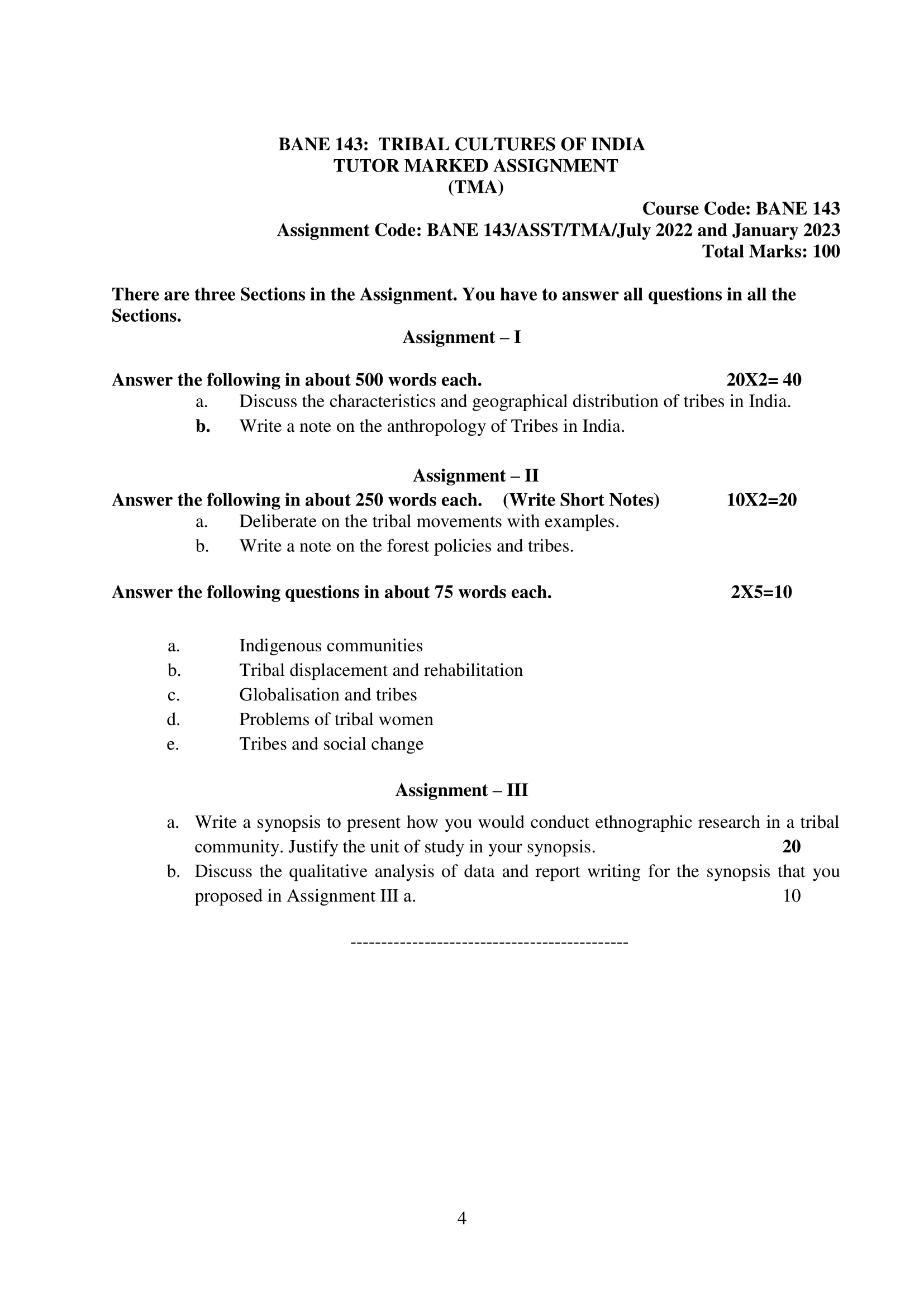
Assignment – I
Answer the following in about 500 words each. 20X2= 40
a. Discuss the characteristics and geographical distribution of tribes in India.
Ans: India is a diverse country with a rich cultural heritage. The country is home to a large number of ethnic groups and tribes, each with its own unique culture, language, and traditions. These tribes have their own distinct characteristics and geographical distribution across the country.
The north-eastern region of India is home to several tribes, including the Nagas, the Mizos, and the Khasis. These tribes are known for their rich cultural heritage and traditional practices. The Nagas, for instance, are known for their intricate shawl weaving and their headhunting practices, which were traditionally performed as a rite of passage for young men. The Mizos are known for their love of music and dance, and their elaborate traditional festivals. The Khasis are known for their matrilineal social structure, where property and inheritance rights are passed down from mother to daughter.
In the central and eastern regions of India, we find tribes such as the Gonds, the Bhils, and the Santhals. These tribes are known for their close relationship with nature and their animistic beliefs. The Gonds, for example, believe in a pantheon of gods and goddesses associated with natural elements such as the sun, the moon, and the forests. The Bhils are known for their hunting skills and their traditional practices of beekeeping and agriculture. The Santhals are known for their traditional music and dance, as well as their religious practices, which include ancestor worship and spirit possession.
In the western and southern regions of India, we find tribes such as the Warlis, the Kolis, and the Siddis. These tribes have a long history of interaction with the wider Indian society and have been influenced by Hinduism and Islam. The Warlis are known for their vibrant paintings, which depict their daily life and beliefs. The Kolis are known for their fishing skills and their traditional beliefs in local spirits and gods. The Siddis are a unique community of African descent, who have lived in India for several centuries. They are known for their traditional music and dance, as well as their Islamic beliefs.
b. Write a note on the anthropology of Tribes in India.
Ans: Anthropology is the study of human societies and cultures, and the field of tribal anthropology in India seeks to understand the diverse cultural practices and social organization of the country’s many tribal communities. In India, there are over 700 recognized tribes, each with their own unique language, religion, customs, and way of life.
One of the key features of tribal communities in India is their close relationship with the environment. Many tribes, such as the Gonds, the Bhils, and the Santhals, have a deep spiritual connection to the land, forests, and animals that they live amongst. This connection is reflected in their religious beliefs and practices, which often revolve around the worship of local spirits and deities.
Another important characteristic of tribal communities in India is their social organization. Many tribes have a strong sense of community and solidarity, with a strong emphasis on sharing resources and supporting one another. For example, the Nagas have a tradition of mutual aid, where members of the community pool their resources to help those in need. The Khasis have a matrilineal social structure, where property and inheritance rights are passed down from mother to daughter.
Tribal communities in India also have their own unique systems of governance. In some tribes, such as the Nagas and the Mizos, decision-making is done through a council of elders. In others, such as the Santhals and the Bhils, the community is led by a headman or chief. In many cases, these systems of governance are closely tied to traditional religious beliefs and practices, with leaders being selected based on their spiritual wisdom and experience.
One of the challenges facing tribal communities in India is their marginalization and exclusion from the wider society. Many tribes have faced displacement and cultural erosion as a result of economic development and globalization. For example, the construction of large dams and mines in tribal areas has often resulted in the displacement of local communities and the destruction of their traditional livelihoods. In addition, tribal communities often face discrimination and prejudice from the wider society, which can limit their access to education, healthcare, and other basic services.
Despite these challenges, many tribal communities in India are making efforts to preserve their cultural heritage and to educate the wider society about their traditions and way of life. For example, many tribes have established cultural organizations and institutes, which promote traditional music, dance, and other forms of art. In addition, there is an increasing recognition of the importance of tribal cultures and traditions in the broader Indian society, and many tribes are now being recognized for their valuable contributions to the country’s rich cultural heritage.
Assignment – II
Answer the following in about 250 words each. (Write Short Notes) 10X2=20
a. Deliberate on the tribal movements with examples.
Ans: Tribal movements refer to the collective actions taken by tribal communities to assert their rights and address the issues that affect their lives. These movements often emerge in response to the marginalization and exclusion of tribal communities from the wider society. In India, there have been several important tribal movements in recent decades, which have sought to address issues such as land rights, cultural preservation, and political representation.
One of the most notable examples of a tribal movement in India is the Narmada Bachao Andolan, which was launched in 1989 to protest against the construction of large dams in the Narmada Valley. The movement was led by local tribal communities and environmental activists, who argued that the dams would displace tens of thousands of people and destroy the local ecosystem. The movement was notable for its use of nonviolent resistance and its focus on community mobilization and awareness-raising.
Another important example of a tribal movement in India is the Adivasi Mahasabha, which was established in the 1920s to represent the interests of tribal communities across the country. The Mahasabha was instrumental in organizing tribal communities to assert their rights and in lobbying for greater political representation. Over the years, the Mahasabha has played a key role in raising awareness about the issues facing tribal communities and in advocating for their rights.
A third example of a tribal movement in India is the Chhattisgarh Mukti Morcha, which was established in the 1980s to address the issues facing tribal communities in the state of Chhattisgarh. The movement was led by local tribal leaders and activists, who sought to address issues such as land rights, access to healthcare, and political representation. The movement was notable for its use of nonviolent resistance and its focus on community mobilization and awareness-raising.
b. Write a note on the forest policies and tribes.
Ans: The relationship between forest policies and tribes in India has been a complex and often contentious one. On the one hand, forest policies have played an important role in protecting forests and wildlife and in conserving biodiversity. On the other hand, these policies have often had negative impacts on the lives and livelihoods of tribal communities, who have lived in and relied on forests for generations.
One of the key challenges facing tribal communities in India is the displacement and loss of livelihoods that result from forest conservation policies. For example, the creation of national parks and wildlife reserves has often resulted in the eviction of local communities from their ancestral lands, with little compensation or alternative livelihood options. In addition, forest policies have often restricted the traditional use of forest resources by tribal communities, including the collection of non-timber forest products, hunting, and fishing.
Another challenge facing tribal communities in India is the lack of representation in forest management decision-making processes. Despite being the primary users and conservators of forests, tribal communities are often excluded from decision-making processes, with decisions being made by government officials and wildlife experts. This exclusion can lead to policies that are disconnected from the needs and perspectives of local communities and that do not take into account the importance of forests for their livelihoods and well-being.
Despite these challenges, there have been some positive developments in recent years, with efforts to recognize the role of tribal communities in forest management and to involve them in decision-making processes. For example, the Forest Rights Act of 2006 recognizes the rights of tribal communities and other forest-dwelling communities to access and manage forest resources, and provides for the devolution of forest management responsibilities to local communities. In addition, there are now initiatives to promote community-based forest management and to provide support for the sustainable use of forest resources by tribal communities.
Answer the following questions in about 75 words each. 2X5=10
a. Indigenous communities
Ans: Indigenous communities are groups of people who have a long-standing historical and cultural connection to a particular geographical area and who maintain a distinct way of life, language, and cultural traditions. Indigenous communities are often marginalized and excluded from mainstream society and face unique challenges, including the loss of traditional lands, the erosion of cultural identity, and limited access to basic services such as healthcare and education. Despite these challenges, indigenous communities often have a rich cultural heritage and a deep understanding of the environment and traditional ecological knowledge. It is important to respect and support the rights of indigenous communities and to acknowledge the valuable contributions they make to our world.
b. Tribal displacement and rehabilitation
Ans: Tribal displacement refers to the forced relocation of tribal communities from their ancestral lands, often due to the development of large-scale projects such as dams, mines, and wildlife reserves. This displacement can result in the loss of traditional lands, resources, and livelihoods, and can have serious impacts on the health, well-being, and cultural identity of affected communities. Rehabilitation refers to the process of providing support and compensation to displaced communities in order to help them recover from the impacts of displacement and to rebuild their lives. Rehabilitation programs may include compensation for the loss of land and property, provision of alternative livelihood options, and support for community-based development initiatives. Effective rehabilitation programs are crucial in ensuring that tribal communities are not left behind in the development process and that their rights and well-being are protected.
c. Globalisation and tribes
Ans: Globalization has had both positive and negative impacts on tribal communities around the world. On the one hand, globalization has brought new economic opportunities, access to new markets, and exposure to new cultures and ideas. On the other hand, globalization has also resulted in the erosion of traditional ways of life, the loss of cultural identity, and the exploitation of resources and labor. In many cases, tribal communities have been marginalized and excluded from the benefits of globalization, leading to increased poverty and social, economic, and political marginalization. To ensure that tribal communities are not left behind in the process of globalization, it is important to promote sustainable development that respects the rights and perspectives of tribal communities and recognizes the important contributions they make to our world.
d. Problems of tribal women
Ans: Tribal women in many parts of the world face significant challenges and barriers that impact their health, well-being, and ability to participate fully in society. These challenges include limited access to education, healthcare, and employment opportunities, as well as high rates of violence, exploitation, and discrimination. In addition, tribal women often face cultural and social norms that limit their ability to participate in decision-making processes and to access resources and services. These problems are compounded by the broader marginalization and poverty experienced by tribal communities, which can result in limited access to basic services and support. To address these challenges, it is important to promote gender equality and to support the empowerment of tribal women through education, economic opportunities, and political participation.
Ans: Tribal communities around the world have undergone significant social change in recent decades, as a result of modernization, globalization, and increased interactions with other cultures. These changes have brought new opportunities and challenges for tribal communities, including exposure to new ideas and technologies, as well as the erosion of traditional cultures and ways of life. In some cases, tribal communities have been able to adapt and thrive in the face of change, while in other cases, change has resulted in marginalization and the loss of cultural identity. To ensure that tribal communities are able to navigate these changes in a positive and sustainable way, it is important to support the rights and perspectives of tribal communities and to promote sustainable development that recognizes and respects their unique cultures and traditions.
Assignment – III
a. Write a synopsis to present how you would conduct ethnographic research in a tribal community. Justify the unit of study in your synopsis.
Ans: An ethnographic study is a research method that focuses on the culture, beliefs, values, and practices of a particular group of people. To conduct an ethnographic study in a tribal community, the following steps would be taken:
- Selection of the unit of study: The unit of study for the ethnographic research would be a specific tribe that has a distinct cultural identity, language, and social structure. The tribe selected should have a rich cultural heritage and a unique relationship with the environment.
- Establishing a research relationship: To ensure that the study is conducted in an ethical and respectful manner, the researcher would establish a relationship with the community by introducing themselves and their research goals, gaining the trust of community members, and obtaining informed consent.
- Data collection: Data collection would involve spending time in the community to observe and document the daily life and cultural practices of the tribe. This would include interviews with community members, participation in community activities, and the documentation of cultural artifacts and symbols.
- Analysis: The collected data would be analyzed to identify patterns and themes in the cultural practices and beliefs of the tribe. The researcher would also look for connections between the tribe’s cultural practices and their relationship with the environment.
Justification of the unit of study: The tribe selected as the unit of study would provide an in-depth understanding of the cultural practices and beliefs of a particular group of people. By focusing on a specific tribe, the researcher would be able to gain a deeper understanding of the tribe’s unique cultural identity, relationship with the environment, and responses to social change. Additionally, by conducting an ethnographic study, the researcher would be able to capture the complexity of the tribe’s culture and to present a nuanced picture of their experiences and perspectives.
b. Discuss the qualitative analysis of data and report writing for the synopsis that you proposed in (Assignment III a).
Ans: Qualitative analysis of data and report writing are crucial components of an ethnographic study. The following steps would be taken to conduct the qualitative analysis and to write the report for the ethnographic study proposed in (Assignment III a):
- Coding and categorization: The collected data would be coded and categorized based on themes, patterns, and relationships. The coding process would involve reviewing the data, identifying key themes and categories, and assigning codes to each piece of data.
- Data interpretation: The coded data would be analyzed to identify patterns and themes in the cultural practices and beliefs of the tribe. The researcher would look for connections between the tribe’s cultural practices and their relationship with the environment, as well as any changes that have taken place over time.
- Report writing: The report would be written in a clear and concise manner, presenting the key findings and conclusions of the study. The report would include a description of the tribe, the research methods used, the data collected, and the results of the analysis. The report would also include a discussion of the implications of the study for the tribe and for broader understanding of tribal cultures.
- Representation of findings: The findings of the study would be represented in a variety of ways, including text, tables, figures, and photographs. The representation of the findings should be clear and accessible to a non-specialist audience.
How to Download BANE-143 Solved Assignment?
You can download it from the www.edukar.in, they have a big database for all the IGNOU solved assignments.
Is the BANE-143 Solved Assignment Free?
Yes this is absolutely free to download the solved assignment from www.edukar.in
What is the last submission date for BANE-143 Assignment?
For June Examination: 31st April, For December Examination: 30th October



